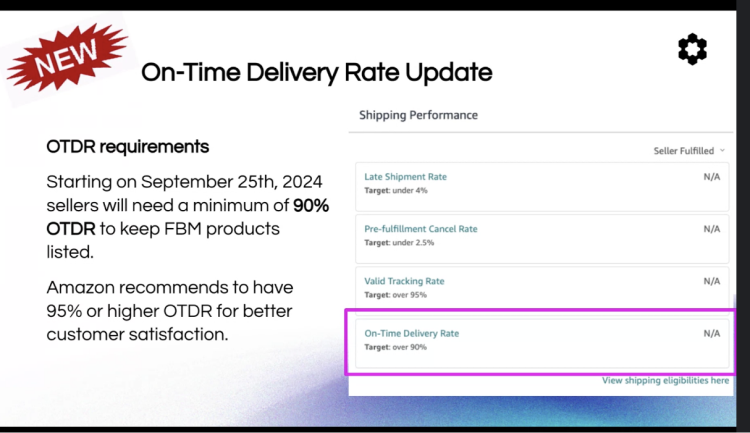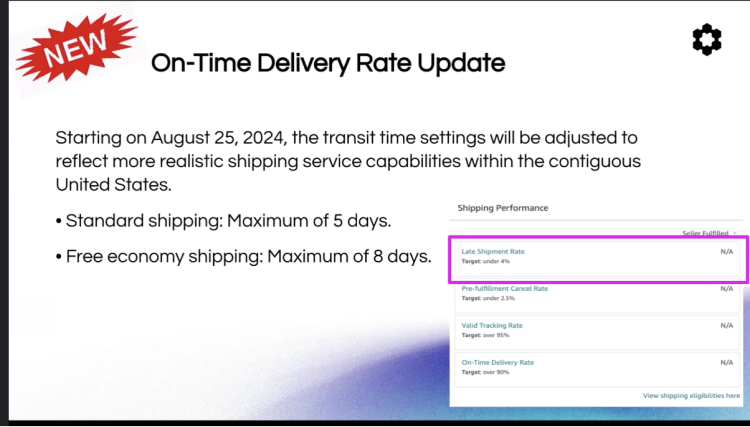Amazon has announced major updates to its on-time delivery rate (OTDR) policy and shipping settings. These changes are intended to enhance delivery reliability and customer satisfaction, but they have sparked mixed reactions among sellers.
Here’s a breakdown of the new policy, its potential impact on sellers, and the community’s feedback.
Key Changes to On-Time Delivery Policy
1. OTDR Requirements
Effective September 25, 2024, FBM sellers will be required to maintain a minimum OTDR of 90% for seller-fulfilled products. This metric measures the percentage of orders delivered on or before the promised date. Sellers not meeting this threshold risk having their listings deactivated.

Amazon also recommends maintaining a 95% OTDR for an optimal customer experience. This policy, however, does not apply to FBA orders, as Amazon manages those delivery timelines.
2. Transit and Handling Time Adjustments

Transit Time
From August 25, 2024, sellers can set a maximum transit time of five (5) days for standard shipping and eight (8) days for free economy shipping within the contiguous United States. These limits aim to standardize delivery expectations and prevent excessively long shipping times.
Handling Time
Starting September 25, 2024, Amazon will implement automated handling time for sellers whose manually set handling times significantly exceed their actual performance. This automated system adjusts handling times based on past data, helping to align seller practices with Amazon’s delivery standards.
3. Tools for Compliance
Amazon provides several tools to help sellers meet these new standards:
- Shipping Settings Automation (SSA): This tool automates transit time calculations based on selected shipping services, ensuring accurate delivery date predictions.
- Automated Handling Tim (AHT): Automatically adjusts handling times for each SKU based on past performance, intended to help sellers meet OTDR requirements.
- Amazon Buy Shipping: Offers sellers reliable shipping options with OTDR protection, provided they use Amazon-approved shipping methods.
Seller Feedback and Concerns
The new policy has received a mixed response from sellers, reflecting both optimism for improved delivery reliability and frustration over increased complexity and potential penalties.
Benefits Highlighted
Some sellers appreciate the tools provided by Amazon, such as SSA and AHT, which can streamline the process of setting accurate delivery dates. For those who already prioritize prompt shipping, these tools offer a way to potentially enhance efficiency and maintain a competitive edge.
Major Concerns
- Loss of Control: Many sellers feel that the new policy strips them of control over their business processes. Automated handling and shipping settings, while intended to improve accuracy, have been criticized for not always aligning with sellers’ operational realities. For instance, sellers have reported discrepancies in delivery expectations, particularly when using Amazon Buy Shipping, where promised delivery dates occasionally misalign with actual carrier performance, leading to feelings of disenfranchisement.
One seller commented, “Our OTDR was 95% when we controlled the settings. Now Amazon is in control of our delivery windows and our OTDR is 91%. Not only can we not control carrier delays but we also can’t stop Amazon from showing what they have calculated as the perfect window. I would love to live right at 91% and be in constant fear of losing my ability to sell.”
- Impact on Seller Performance Metrics: Sellers are concerned about the potential negative impact on their performance metrics due to factors outside their control, such as carrier delays. Even when using Amazon’s recommended tools, sellers can still face penalties for late deliveries caused by third-party carriers.
- Transparency and Communication: There is a significant frustration regarding the perceived lack of transparency and effective communication from Amazon. Sellers express confusion over sudden changes in policies and metrics, which they feel are not adequately explained or justified. This confusion is exacerbated by issues like discrepancies in delivery time reporting, particularly with time zone conversions in performance metrics.
- Tension Between Amazon and Third-Party Sellers: The reactions also highlight a growing tension between Amazon and its third-party sellers, particularly those who do not use FBA. Some sellers interpret these policies as an effort to push more sellers towards FBA, where Amazon has greater control over fulfillment and delivery standards. This perception of bias towards FBA can contribute to a sense of mistrust and dissatisfaction among FBM sellers.
One seller wrote, “Another everyday stressor unlocked. It will be impossible to maintain perfect 100% OTDR any longer. The only way to be over 90% is to increase your settings for transit and handling time, which will reduce your ability to be eligible for a Featured Offer. This puts all FBM in even bigger disadvantage compared to FBA. With increased FBA inbound fees, low stock, old stock fees and slow consumer economy, it’s going to be a fun end of the year.”
Potential Financial Impact: The requirement to use Amazon’s shipping tools, which may not always be cost-effective or suitable for all products and shipping scenarios, poses a financial burden on sellers. This is especially concerning for small businesses and those dealing with niche or perishable items, where margins are already thin.
Overall, sellers’ feedback reveals difficulties in adapting to frequent and sometimes unexpected policy changes. The frustration expressed by sellers about having to continually adjust to new requirements underscores the challenges they face in maintaining compliance while managing their own operational realities.
These reactions suggest that while Amazon strives to maintain a high standard of service for its customers, it faces challenges in balancing this goal with the needs and capabilities of its seller community. The relationship between Amazon and its sellers is characterized by both reliance and tension, with ongoing challenges in communication, support, and the implementation of new policies.
Strategies for Navigating These Changes Successfully
Adjusting to Amazon’s new on-time delivery rate (OTDR) policy and shipping settings can be challenging, but there are several strategies sellers can adopt to navigate these changes successfully.
Optimize Handling and Transit Times
- Review and Adjust Settings: Regularly review your handling and transit times. Ensure they accurately reflect your capabilities and the shipping services you use. If you consistently dispatch items faster than your current handling time settings indicate, consider shortening these times to better align with your actual performance.
- Use Shipping Settings Automation (SSA): Implement SSA to automate transit time calculations based on your preferred shipping services. This tool helps ensure that delivery date predictions are accurate, reducing the risk of late deliveries, especially during peak season.
- OTDR Protection: Use Amazon Buy Shipping for your orders, especially those with the “OTDR Protected” label. This service provides protection against late delivery penalties if delays are due to the carrier rather than your handling.
- Choose Reliable Shipping Methods: Opt for shipping methods known for reliability and timely delivery. This can help minimize issues that might affect your OTDR.
Leverage Technology and Data
- Use Data Analytics: Monitor your OTDR and other key performance indicators using available analytics tools like Amazon’s Fulfillment Insight Dashboard. This data can help you identify trends, anticipate potential issues, and make informed decisions to improve delivery performance.
- Automate Where Possible: While maintaining control over your operations, consider automating aspects of your order fulfillment process, such as label printing, order tracking, and inventory management. Automation can help reduce errors and improve efficiency.
Monitor and Improve Performance Metrics
- Regularly Check Your OTDR: Keep a close eye on your OTDR through the Account Health dashboard. Understanding your current performance allows you to take corrective actions before it affects your account status.
- Use Data Analytics: Take advantage of available analytics tools to identify trends, anticipate potential issues, and make informed decisions to improve delivery performance.
- Address Issues Promptly: If you notice patterns of late deliveries or other issues affecting your OTDR, investigate the causes. It could be due to specific carriers, times of the year, or shipping routes. Taking corrective action early can prevent these issues from recurring.
Communicate with Customers
- Set Clear Expectations: Clearly communicate shipping and delivery expectations to your customers. This includes realistic delivery windows and any potential delays due to factors like high demand or shipping disruptions.
- Provide Timely Updates: If a delay does occur, proactively inform your customers. Transparency can help maintain customer satisfaction even when issues arise.
Build a Flexible Shipping Strategy
- Diversify Shipping Options: Offer a range of shipping options, including standard, expedited, and economy, to cater to different customer needs and preferences. This flexibility can help manage customer expectations and improve overall satisfaction.
- Build Contingency Plans: Have contingency plans in place for common issues like carrier delays, inventory shortages, or unexpected spikes in orders. Being prepared for these situations can help you respond quickly and minimize disruptions.
- Plan for Peak Seasons: Anticipate peak shopping periods and adjust your inventory and staffing levels accordingly. Planning ahead can help you maintain high service levels even during busy times.
Stay Informed and Adapt
- Keep Up with Amazon Policies: Regularly check Amazon’s announcements and updates to stay informed about policy changes. Understanding these changes early allows you to adapt your practices accordingly.
- Seek Support When Needed: If you’re unsure about how the new policies affect you or how to implement changes, reach out to Amazon Seller Support for clarification.
Evaluate the Use of FBA
- Consider FBA: If managing OTDR and shipping logistics becomes too challenging, consider using FBA for some or all of your products. This service shifts the responsibility for meeting delivery promises to Amazon, potentially improving your performance metrics.
Adapting to Amazon’s New Delivery Standards
Amazon’s updates to its OTDR policy and shipping settings aim to enhance delivery reliability and customer satisfaction. However, these changes also bring challenges and concerns for sellers, particularly around the loss of control, potential penalties for factors beyond their control, and the financial implications of adopting new tools and processes.
As sellers navigate these changes, the ongoing dialogue between Amazon and its seller community will be crucial in addressing these concerns and ensuring that the platform remains a viable and attractive marketplace for all parties involved.








